Farm Visit to JSM Organics with Congressman Panetta and Under Secretary Moffitt
 Print This Post
Print This Post
By Ann Baier, NCAT Sustainable Agriculture Specialist
ATTRA staff had been planning for months to create a video tour of JSM Organics, one of the Latino-owned farms featured in this year’s Latino Farmer Conference (more on that later). Early on the day we scheduled to film, we were greeted by owner Javier Zamora, who had been there for hours already, checking market orders and preparing harvest lists. As we walked the farm fields, we were treated to unusual planting arrangements: Bright sunflowers filled the corner of a field, and cauliflower and Brussels sprouts were growing amid strawberry plants near the end of their productive season. Javier explained that, with so much investment in bed preparation and installation of drip irrigation, growing a second crop takes advantage of the space and nutrients as the berry crop dwindles.
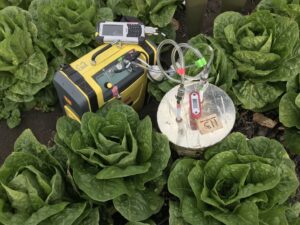
Instruments measuring the composition of gases as indicators of organic matter and biological activity in the soil.
In a succulent field growing green romaine, Javier introduced us to a pair of researchers from California State University Monterey Bay. The women described how their instruments were measuring the composition of gases as indicators of organic matter and biological activity in the soil. As interesting as it was to hear about the preliminary findings reinforcing the benefits of compost, time was short, so we hopped into Javier’s vehicle.
We headed off the farm, passing the “milpa,” a field planted in corn, beans, and squash interspersed with bright orange strawflowers for fall bouquets. Javier made respectful requests of field workers for harvest of certain berries and flowers. Good working relationships are critical to his business. “I’m absolutely zero without them,” he said of his skilled and capable crew of full-time employees and seasonal H2A visa workers, for whom he provides housing and transportation, as well as a living wage. Driving up the farm road, Javier phoned to confirm the time and place for the taco truck to serve a delicious lunch (including freshly harvested romaine) to the guests who would visit the farm later.
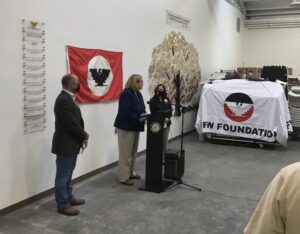
USDA Under Secretary for Marketing and Regulatory Programs Jenny Lester Moffitt and Congressman Jimmy Panetta at the grant announcement event.
We were not the only ones seeking Javier’s perspective and wisdom that day. Two days prior, Javier received a request from USDA Under Secretary for Marketing and Regulatory Programs Jenny Lester Moffitt and Congressman Jimmy Panetta to attend an event to announce USDA’s Pandemic Response and Safety Grant and Farm and Food Worker Relief Grant (deadline to apply is February 28, 2022). Javier’s wife Paola, and their daughter Cynthia, who, after completing her university education, will be rejoining the farm business also attended the event. Afterward, Javier was interviewed by both English- and Spanish-language news channels, in which he described how farmers like him were weathering the pandemic and how these programs could help.
Representative Panetta and Under Secretary Moffit visited the farm and walked around the fields. They listened to the many ways policy decisions impact farmers’ day-to-day and year-round operations. Discussing crop insurance needs of certified organic farmers, Javier explained several challenges related to crop insurance coverage for certified organic producers, and the cash flow challenge when insurance premiums come due in the off-season and shortly after property taxes must be paid.
Amid rows of raspberry canes bearing fruit along the warm end of the color spectrum, the dignitaries sampled the array of specialty varieties. The array of golden yellow, glowing translucent orange “double gold,” and rich red improve marketing options for a small farmer. From another field, workers brought unassuming small strawberries with large flavor. Javier explained how the hoop houses, constructed with the help of Natural Resource Conservation Service (NRCS) cost–share programs, enable him to extend the berry harvest season and grow quality fresh market herbs.
In another field, Javier offered tastes of many sweet and flavorful varieties of tomatoes that were winding down their season. Nearby, a few leeks that remained after the field’s first harvest now lend vertical interest to colorful bouquets. Flowers grow almost everywhere on this farm. Not only do they add beauty for those who work on the farm, they also increase biodiversity, provide habitat for beneficial insects to enhance natural biological control, and provide an important marketable product, so the farm feeds customers’ spirits as well as their bodies. The diversity of crops and flowers brings nourishment and delight to a diverse of customers who at multiple farmers markets around the Monterey Bay and San Francisco Bay Area.
When all the other visitors left, we walked back into the field to take the video originally planned. It was late, and we were all tired. Yet we had a richer appreciation for the many roles Javier sees himself fulfilling.
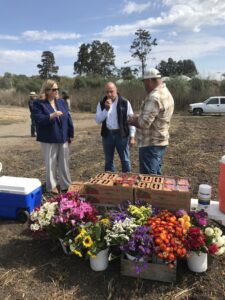
Berries for dessert after the farm tour.
Javier summarized the four key cornerstones of his sustainable agriculture operation, which we had been seeing in action throughout the day:
1) Everybody who works for us is happy, comfortable, and has a smile.
2) Customers understand our prices will be higher than the norm. [Producing quality and flavor requires great care and attention; it is appropriate to provide adequate compensation to everyone working to bring these products to market.]
3) We use healthy farming practices that feed the soil and reduce pest pressures.
4) We collaborate with many people and organizations.
Today was just one example of how Javier invests time and energy into maintaining vibrant relationships that nurture a more sustainable food and farming system. He hosts learning opportunities with nonprofit organizations like NCAT, which supports farmers through its ATTRA sustainable agriculture program. He serves on the regional water board to seek better natural resource management. And he educates policy-makers and agricultural leaders to increase mutual understanding for more informed decisions.
I am inspired by Javier’s positive approach and his ability to effectively articulate the challenges farmers face. JSM Organics’ innovative practices build healthy soils and farm ecology, and produce nutritious, delicious, and beautiful food and flowers to sustain both body and spirit. This farm maintains respectful relationships and creates dignified livelihoods for all who work there. Communicating a well-grounded vision to people in positions of power, while demonstrating it in practice, sows seeds of understanding and can lead to better policies. Many people in this family and on the farm are investing great energy and insights to build healthier communities.
Please join us for the 7th Annual Latino Farmer Conference, which will feature the video farm tour of JSM Organics. The conference will be held virtually as a three-part webinar on December 8, 2021, and January 12 and February 9, 2022. All sessions are presented entirely in Spanish. Each webinar includes a video tour of a Latino-owned farm and focuses on conservation farming. Together we’ll learn from presentations and discussions with ag resource professionals and innovative farmers like Javier, Paola, Cynthia, and their whole farm team. Register here.
Related ATTRA Resources:
7th Annual Latino Farmer Conference
This blog is produced by the National Center for Appropriate Technology through the ATTRA Sustainable Agriculture program, under a cooperative agreement with USDA Rural Development. ATTRA.NCAT.ORG.
All photos by Ann Baier, NCAT

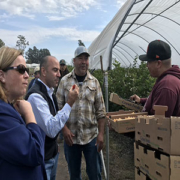
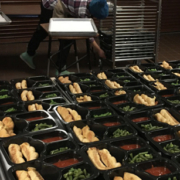

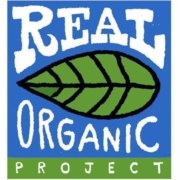
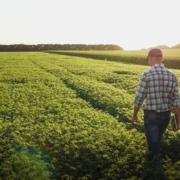
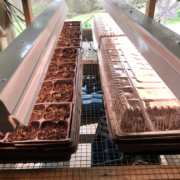
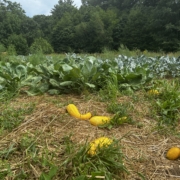

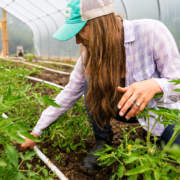 USDA NRCS Flickr
USDA NRCS Flickr

